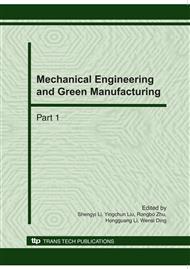p.582
p.587
p.591
p.595
p.600
p.605
p.610
p.616
p.621
Research on Optimization of Air Blowing System
Abstract:
Many studies have been made for years on dimensions of pneumatic nozzle. To output same blowing force, the supply pressure could be reduced by decreasing the ratio of length to diameter of nozzle. The friction between high speed air and pipe wall would be reduced if the nozzle is designed to be converging shape comparing with straight shape. But the volume flow and pressure, discussed in these studies, do not describe energy loss of the blowing system directly. Pneumatic power is an innovative principle to estimate pneumatic system’s energy consumption directly. Based on the principle, the supply pressure of air blowing system is a critical parameter concerning energy consumption and blowing force. In the experiment, the air blowing system is supplied by a compressor and an air blower respectively. The pressure of air from the compressor is times higher than air blower. A comparison is preformed to the two systems about energy consumption and blowing force. From the result, the air blowing system with air blower consumes less energy than with compressor. This study provides theoretical basis for designing energy-saving air blowing system.
Info:
Periodical:
Pages:
600-604
Citation:
Online since:
October 2010
Authors:
Keywords:
Price:
Сopyright:
© 2010 Trans Tech Publications Ltd. All Rights Reserved
Share:
Citation:


